Restoration
We provide Rug Restoration, Carpet Restoration, Rug Repair, Persian Rug Restoration, Silk and Oriental Rug Restoration and expertly skilled Oriental Rug Care and Maintenance to our clients in the areas of Machine Rug Hooking, hand sewing of machine woven fringes, rug refinishing, rug replenishment and moth disposal in superior quality according to our internal company standards, IICRC™ guidelines and norms and the expertly implemented PERSIAN® system.
Our company will educate you on how to properly care for your natural rugs and fabrics, how to clean and use them properly so that they do not deteriorate unnecessarily and last you a long time in the best possible condition.
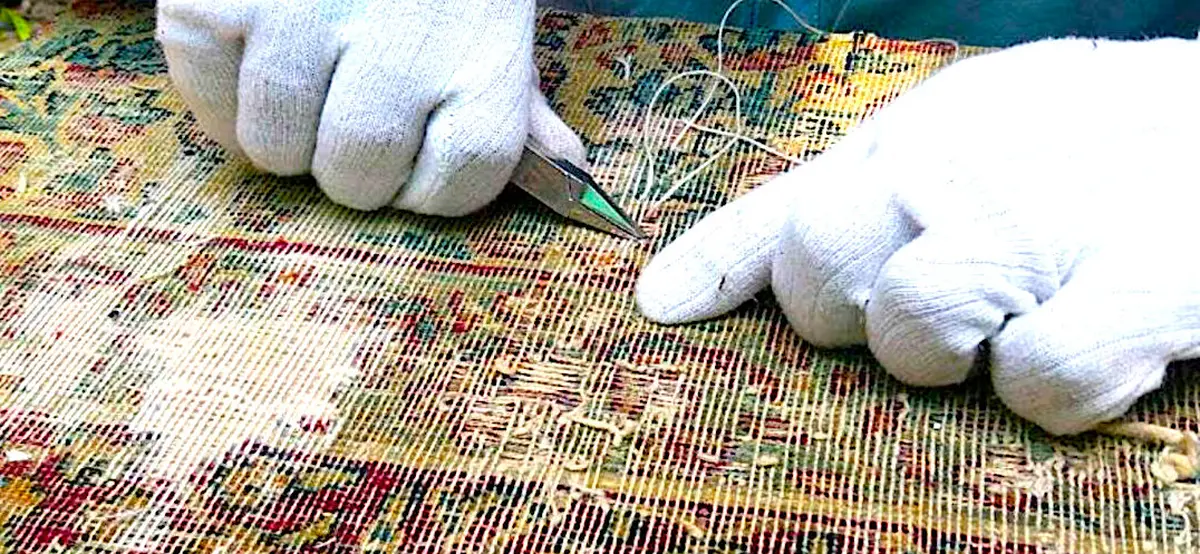
 the PERSIAN® trademark defines the branded technology concept of the expertly qualified Rug Service® implementation company focused on regular maintenance, cleaning, revitalization and impregnation of artificial, natural, wool, Persian and silk rugs, textile and leather sofas, chairs and upholstered materials. This branded concept brings the utmost professionalism in full synergy with maintaining ethical, environmental and quality performance standards including contractual guarantee of the services provided by the contractor.
the PERSIAN® trademark defines the branded technology concept of the expertly qualified Rug Service® implementation company focused on regular maintenance, cleaning, revitalization and impregnation of artificial, natural, wool, Persian and silk rugs, textile and leather sofas, chairs and upholstered materials. This branded concept brings the utmost professionalism in full synergy with maintaining ethical, environmental and quality performance standards including contractual guarantee of the services provided by the contractor.
The word “rug” in foreign languages has certain similarities and is based on the ancient Greek word tapestos. In German it is teppich, in French it is tapis, in Italian tappeto, in English Rug. Rug is used for larger and large formats, and rug is used for smaller ones and prefixes or treads. Rug, or rug in English, is derived from the Latin word cooperire – to cover, to drape.
Real hand-knotted rugs from the Orient are considered the most beautiful and finest in the world. In the past they were often found in classically furnished homes, but for several years they have been appreciated especially for their originality and authenticity. With the return to true values, oriental rugs are now also back in fashion. Whether they are rustic, bourgeois or modern rugs, they blend in seamlessly and add a warm, cosy atmosphere to any room. Especially for modern interiors, which are often simple and straightforward, a classic rug can add an exotic and valuable touch.
Definition of an oriental rug
The variety of oriental rugs and their characteristics is often difficult to understand, even for experts. Even with the term “Orient”, it is often not clear exactly which region it refers to. This gap has arisen due to different approaches to evaluation. While today we usually identify the Muslim countries of the Near and Middle East with the Orient, previously the Orient was called the Orient . This included all Asian countries south of Russia, including China, and North African countries. The Oriental rug is also based on this older definition of territory, and therefore includes Moroccan and Chinese rugs.
What makes a hand-knotted oriental rug an oriental rug?
Quality oriental rugs are most often made from hand-spun sheep’s wool, more rarely from goat or camel wool. For greater strength and durability, cotton fibre is also increasingly used for the warp, the pile is usually wool, sometimes cotton. More luxurious rugs may be all-silk or with silk pile on a cotton warp. At first glance, they are characterised by their high sheen. Exceptionally, metallic fibres are used – silver or gold.
Knotted rugs (with pile) are divided according to the type of knot. Basically, all rugs are knotted with either a symmetrical (Turkish, ghiordes) knot or an asymmetrical irregular (Persian, senneh) knot. These are not knots in the true sense of the word, but only loops that are stretched around two, rarely three or four warp threads.
symmetric knot (Turkish)
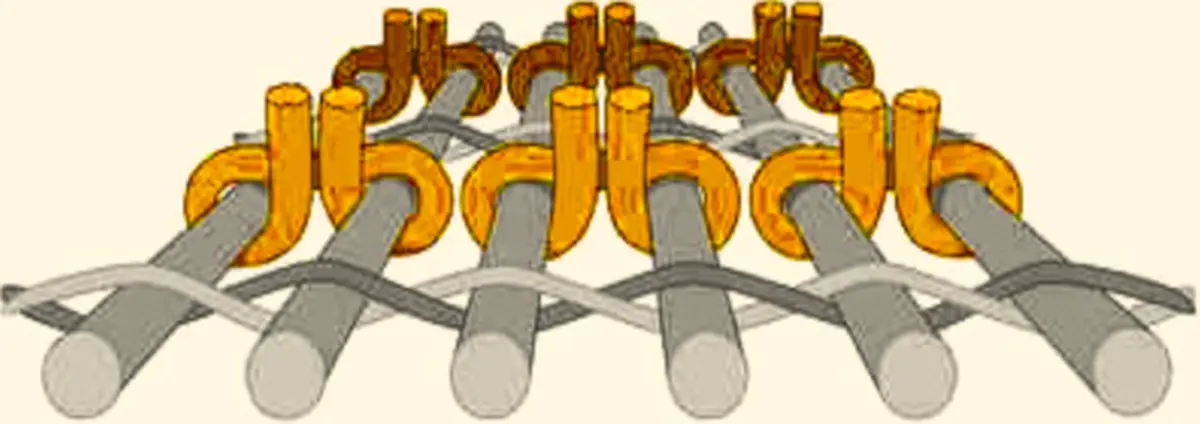
asymmetric knot (Persian)
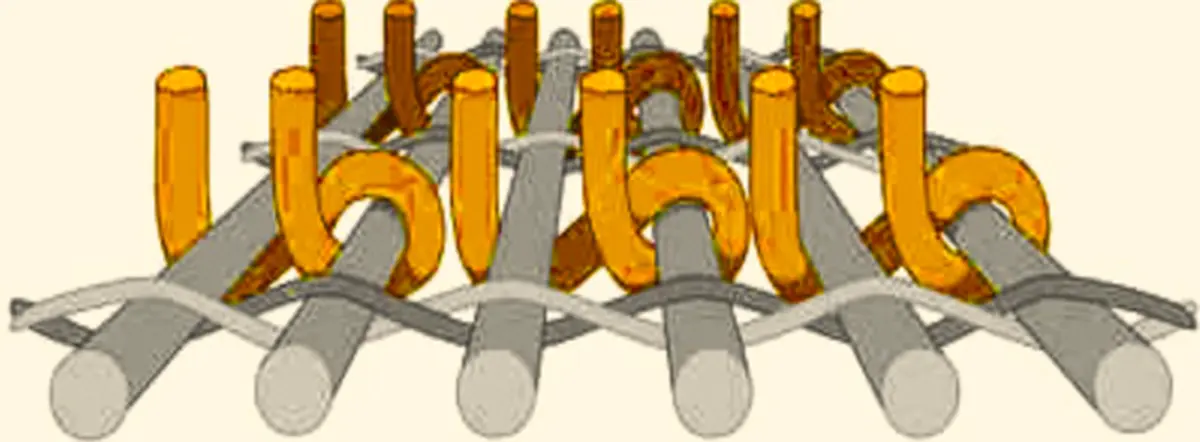
The two main types of nodes are easy to distinguish. Fold the rug lengthwise across the width, i.e. in the direction of the weft. In a symmetrical (Turkish) knot, the wool is wrapped around the two adjacent warp threads and the ends of the knot pass between them. In an asymmetrical (Persian) knot, the loop is twisted around one warp thread and the other half is twisted around the next warp thread, so the second warp thread lies between the two ends of the knot. As a result, when looking into the pile of a symmetrical (Turkish) weave, the warp is not visible, whereas in the case of an asymmetrical (Persian) weave, one of the two warp threads can be seen.
To distinguish the type of knot in very well knotted rugs, we need a magnifying glass. The difference between Turkish and Persian weave does not indicate any difference in the quality of the rug. In a very well knotted rug, the asymmetrical Persian knot allows slightly more versatility for more complex motifs, to create softer lines.
The density of knots (finish) per 1 dm² is determined by the thickness of the material used, which means that silk rugs are much finer than wool rugs. In fact, finely knotted rugs command a higher price than coarsely knotted rugs. This is because the cost of the material is higher and it takes longer to make. Still, it is not a rule that a rug with a higher density of knots must be better and more expensive. The quality and price of rugs is influenced by many other factors – the age of the rug, its uniqueness, the quality of the weaving, the workmanship of the material and colour and last but not least the place of origin, originality and pattern.
The delivery is best determined on the reverse side of the rug. We always count 10 cm of horizontal and 10 cm of vertical knots, then multiply these numbers. The best result is obtained by calculating the diameter from several different parts of the rug. When counting knots in the horizontal direction (after weft) it is important to remember that each knot passes through 2 warp threads.
Representative rug quality by number of knots per 1 dm²:
- Up to 500 knots – very coarse
- 500 – 1000 knots – coarse
- 1000 – 2000 knots – medium fine
- 2000 – 2500 knots – fine
- 2500 – 4500 knots – very fine
- above 4500 knots – extremely fine
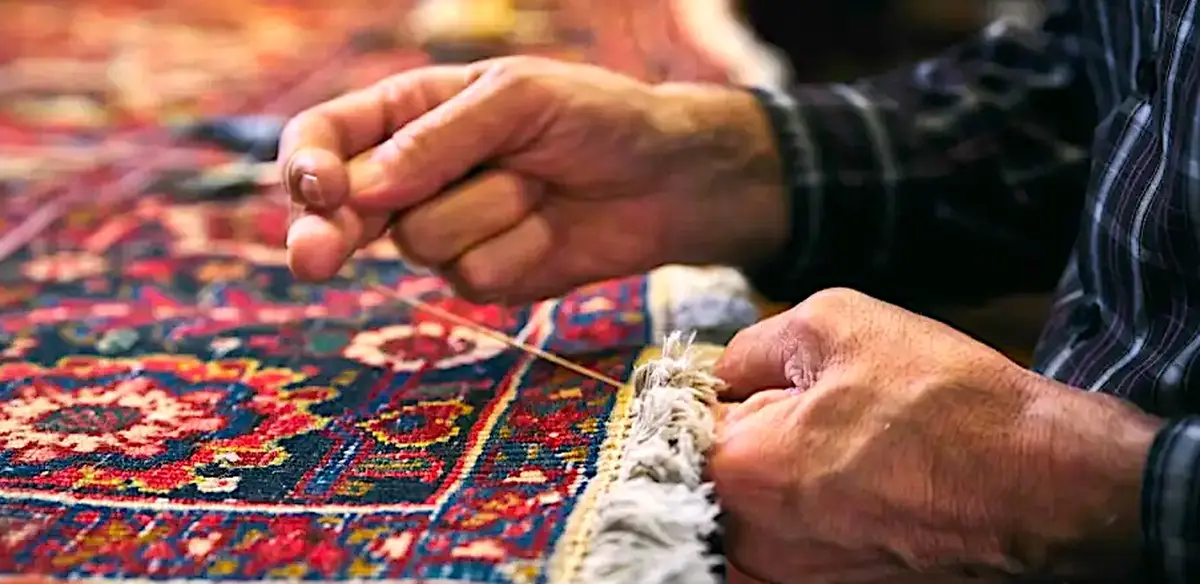
Oriental rug restoration
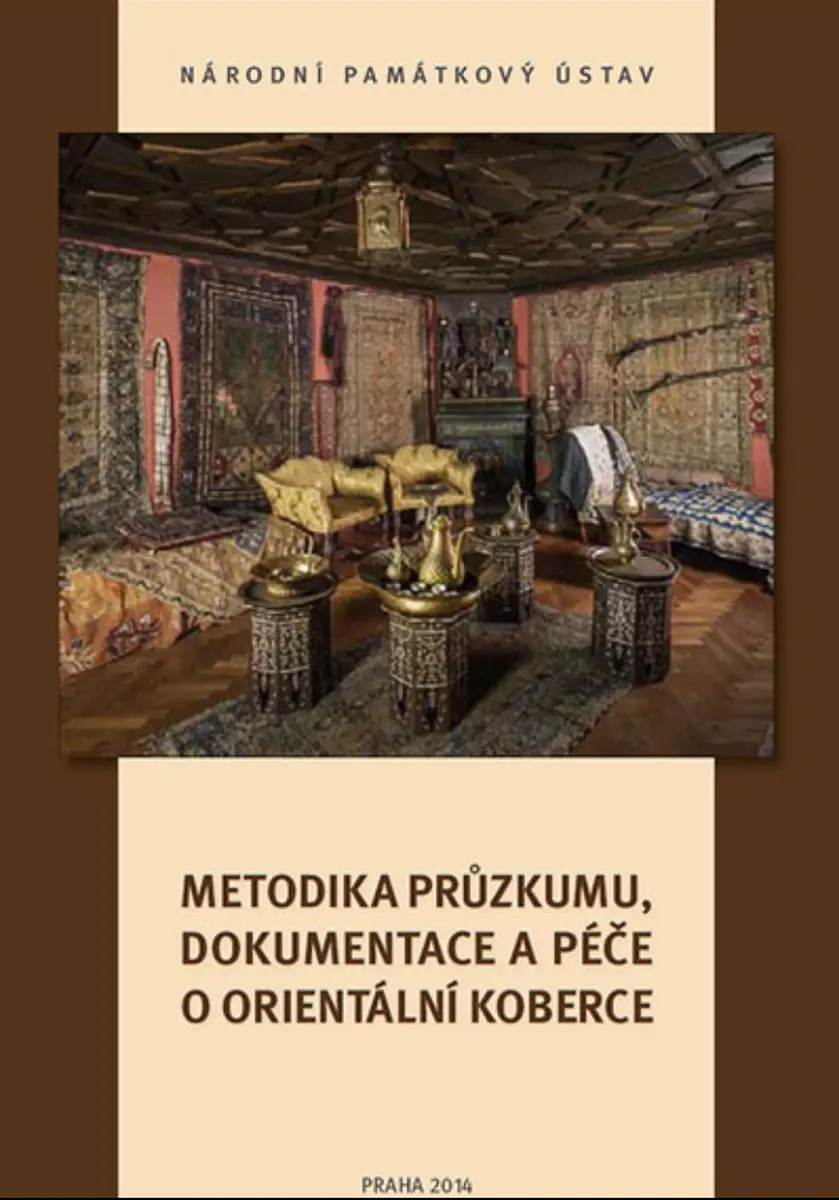 The methodology of textile renovation and restoration is intended for professionals in the field of heritage conservation, including those who regularly encounter this material. The restoration methodology introduces the origins, production technology, symbolism, original and secondary use of oriental rugs and gradually guides in the individual steps to the treatment of this material (basic records, documentation, gives instructions for the care of historical oriental rugs, establishes the treatment regime and exhibition use). Restoration of tapestries, rugs and conservation of historical textiles is an important part and activity of our company. We deal with the conservation of large tapestries, historic rugs and also restore textiles.
The methodology of textile renovation and restoration is intended for professionals in the field of heritage conservation, including those who regularly encounter this material. The restoration methodology introduces the origins, production technology, symbolism, original and secondary use of oriental rugs and gradually guides in the individual steps to the treatment of this material (basic records, documentation, gives instructions for the care of historical oriental rugs, establishes the treatment regime and exhibition use). Restoration of tapestries, rugs and conservation of historical textiles is an important part and activity of our company. We deal with the conservation of large tapestries, historic rugs and also restore textiles.
Before the actual restoration, an assessment of the damage to the textile in question is always carried out. Subsequently, a repair is proposed, including its budget – as a matter of principle, we first give the conservation option which, in our judgment, would be the best to restore the historic textile as well as possible and to extend its life as long as possible. Of course, however, we respect the investor’s interest in terms of the scope and type of conservation work to be carried out and the restoration itself will therefore only begin after agreement with the investor.
We approach the preserved historical material sensitively with the aim of preserving it in its entirety. We repair both minor and extensive damage and are able to touch up missing parts of damaged areas.
Restoration methods/techniques and types of preserved textiles
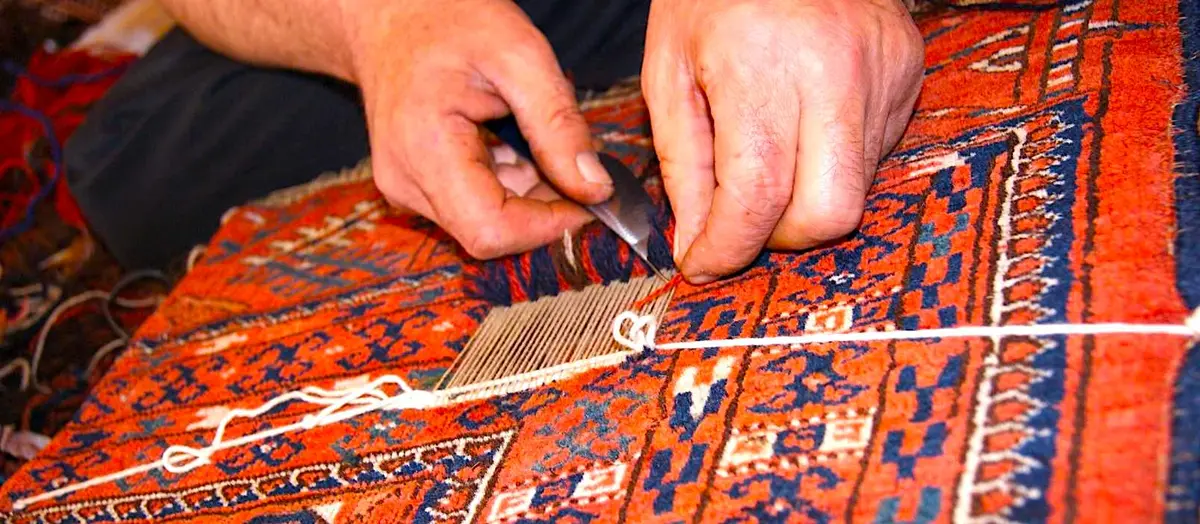 We specialize in restoring and conserving textiles using various sewing restoration or conservation methods such as imperceptible textile retouching and reconstruction, sewn full skeletonization on linen backing with preservation of the principle of reversibility of intervention, etc. We approach the historical preserved material sensitively with an attempt to preserve it in its entirety. We repair both minor and extensive damage, and are able to touch up missing areas of such damaged material as part of the restoration of kilim woven and hand knotted oriental and other rugs.
We specialize in restoring and conserving textiles using various sewing restoration or conservation methods such as imperceptible textile retouching and reconstruction, sewn full skeletonization on linen backing with preservation of the principle of reversibility of intervention, etc. We approach the historical preserved material sensitively with an attempt to preserve it in its entirety. We repair both minor and extensive damage, and are able to touch up missing areas of such damaged material as part of the restoration of kilim woven and hand knotted oriental and other rugs.
Cleaning as part of the restoration work is a frequent task. We do this for textiles and rugs that have been soiled in any way (mechanically, nicotine, oily dust, etc.). Cleaning is always carried out before restoration or conservation work begins or even separately if restoration work is not carried out afterwards.
Cleaning process with or without restoration preparation
- Investigation of the state of soiling of the textile and assessment of the cause and manner of soiling
- To determine the method and method of subsequent cleaning, first carry out tests on the colour fastness of the individual colours of the textile fibres from which the textile is made
On the basis of the results of these tests and in agreement with the investors of the individual works, we select the appropriate method and procedure for cleaning the textile, which we carry out by various methods:
- First, we rid the soiled textile of dusty surface parts that may chemically erode the individual textile fibres over time by sensitive hand vacuuming through a protective textile net.
- If the colour fastness tests show that the colours do not set in a wet cold or warm bath, we choose the wet way to clean them in a water bath (demineralised and non-ionised water) and with the addition of a neutral pH detergent.
- For textiles where there is a concern that the dyes may become baked on in the wet process, we carry out cleaning with the so-called Dry cleaning, i.e. with dry foam, special powders removing dust particles, any localised heavy soiling by chemical cleaning, wax stains with absorbent paper and heating, and various special textiles (e.g. ornaments, mitres etc.) are then cleaned by successive gentle, hand rubbing with distilled water and detergent.
- Cleaning historic textiles.